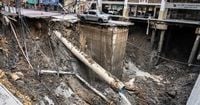Bangkok, Thailand, was rocked by a dramatic infrastructure failure on Wednesday, September 24, 2025, when a massive sinkhole swallowed a large section of a busy city street, disrupting daily life and drawing national attention. The incident, which unfolded just before the morning rush hour, left a gaping hole in the heart of the capital, forcing evacuations, halting traffic, and exposing the vulnerabilities of a rapidly growing metropolis grappling with the demands of modernization.
According to Reuters and USA TODAY, the sinkhole opened up in front of Vajira Hospital and a nearby police station in central Bangkok, creating a chasm that measured approximately 9,687.52 square feet (900 square meters) in area and plunged to a staggering depth of 164 feet. Eyewitness videos captured the dramatic moment as the ground gave way, swallowing cars, electrical poles, and chunks of asphalt. Utility poles were sucked into the void with such force that sparks flew, plunging surrounding neighborhoods into darkness and leaving the foundations of nearby buildings exposed to the elements—an especially worrying prospect during Thailand’s rainy season.
The timing of the collapse—around 7 a.m. local time—proved to be a stroke of luck. Two parked cars fell into the hole, but, remarkably, no one was inside either vehicle, and authorities confirmed that no deaths or injuries occurred. As Thailand’s Prime Minister Anutin Charnvirakul told reporters, “Luckily, there are no deaths or injuries.” This sentiment was echoed by Bangkok’s Governor Chadchart Sittipunt, who noted that while the hospital remained structurally secure thanks to its underground walls, the police station was evacuated out of an abundance of caution. “The hospital has no problems, but we are worried about the police station,” said Governor Chadchart. “That’s still dangerous, and the public has been evacuated.”
The cause of the collapse was quickly traced to ongoing construction work beneath the city. Officials from the Bangkok Metropolitan Administration and the Mass Rapid Transit Authority of Thailand determined that a water leak from a burst pipe in a tunnel—part of the city’s ambitious Purple Line subway extension—had undermined the ground above. As Prime Minister Anutin Charnvirakul explained, “Dirt from an underground train construction was sliding in.” The burst pipe allowed water to erode the soil supporting the road, eventually triggering the catastrophic collapse. The tunnel in question is part of a major infrastructure project aimed at connecting Bangkok’s western suburbs to the Dusit district, a historic riverfront area famed for its royal palaces, Buddhist temples, and old shop houses.
The sinkhole’s proximity to key city landmarks added to the sense of urgency. The gaping hole was less than two miles from Dusit Palace, the residence of the Thai royal family, and the Purple Line extension itself runs beneath the Parliament complex and the National Library. As a result, city officials moved swiftly to assess the risk to surrounding structures. The area’s water supply was cut off immediately after the collapse, and authorities inspected buildings in the vicinity, including the hospital and police station. Thankfully, the hospital’s robust underground walls kept it safe from further harm, but the police station’s location near the edge of the sinkhole prompted a full evacuation.
The impact on daily life was immediate and far-reaching. Traffic in central Bangkok ground to a halt as the road closure snarled commutes and forced detours, while residents and workers in the area were ordered to evacuate for their safety. Vajira Hospital, a vital healthcare facility, announced it would not accept new patients for the duration of the emergency. Meanwhile, authorities worked through the day to stabilize the site. By noon local time, officials reported that further ground movement had been stopped, but they continued to monitor the situation closely, wary of additional collapses.
Indeed, their caution proved justified. In the early hours of Thursday, September 25, a secondary collapse occurred, erasing the remaining strip of tarmac that had miraculously supported a Toyota Hilux pickup truck during the initial incident. The iconic image of the lone vehicle teetering on the edge of the abyss had briefly become a symbol of the city’s luck amid disaster; its subsequent disappearance underscored the ongoing danger posed by the unstable ground.
Behind the scenes, high-level meetings took place to coordinate the response. Officials from the Mass Rapid Transit Authority met with Prime Minister Anutin Charnvirakul and Governor Chadchart Sittipunt on Wednesday morning to discuss the incident and chart a path forward. The Bangkok Expressway and Metro, which operates the existing Purple Line, clarified that it was not involved in the construction of the new extension, distancing itself from the project at the center of the crisis.
The incident has sparked broader questions about urban development and infrastructure safety in Bangkok. As reported by AP and The New York Times, the rapid expansion of the city’s transit system is seen as essential for easing chronic traffic congestion and supporting economic growth. However, the collapse has exposed the risks associated with large-scale underground construction in a densely populated, flood-prone city. The rainy season only compounds these challenges, as saturated soil and high water tables increase the likelihood of ground instability.
For local residents, the sinkhole was a frightening reminder of the fragility of the urban environment. Many expressed relief that the disaster had not claimed any lives, but concerns lingered about the safety of other construction sites and the integrity of aging infrastructure. City officials have promised a thorough investigation into the collapse and pledged to implement stricter oversight of ongoing projects. As Governor Chadchart put it, the priority is “to ensure public safety and restore confidence in the city’s infrastructure.”
As of Thursday, the affected area remains cordoned off, with engineers and emergency crews working around the clock to repair the damage and prevent further incidents. The hospital has resumed limited operations, and power has been restored to most nearby neighborhoods. Yet, the memory of the ground giving way beneath their feet will likely haunt Bangkok residents for some time. This dramatic event has served as a wake-up call for a city racing to modernize while contending with the unpredictable forces of nature and the hidden dangers beneath its streets.
While the dust settles and repairs begin, Bangkok faces a pivotal moment—balancing ambition with caution, and ensuring that progress does not come at the cost of public safety.




